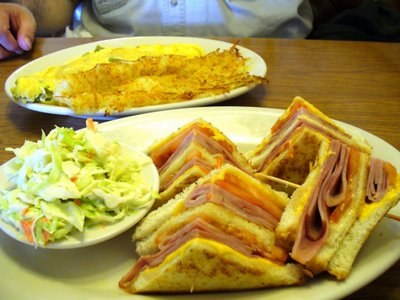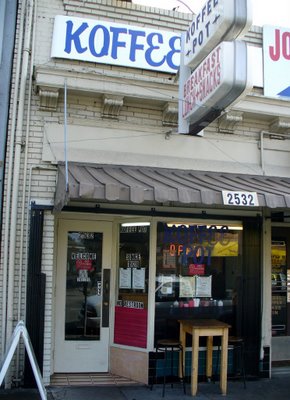Curly's Coffee Shop

To be in North Beach today means there is no overt anti-Asian sentiment one immediately notices. That's not to say there isn't any, but whatever there is remains covert.
I hear it sometimes in subtle ways, such as the City Lights Bookstore owner fondly reminiscing how "in the old days" the Italian immigrants of North Beach were more receptive to anarchism as opposed to the new immigrants who make up the neighborhood now, meaning Asians. This is likely true, but then what remains of your average Italian in North Beach isn't exactly a fellow traveler of the Left, neither.
Other times, it's more overt and in your face, such as the butcher at Little City Meats telling me that I probably shouldn't bother asking for pork fat scraps from the Chinese butchers because they don't sell to whites.
You know, I don't need to hear that jive. If it's true, then I'll find out on my own, but I don't need you telling me something I know isn't true – because I patronize Chinese butchers. And like Stevie Wonder/Paul McCartney once said, "there is good and bad in everyone".

Overt or subtle, what I see are people who are sore over the enormous Asian expansion into areas abandoned by Italian white flight during the last three decades, and frankly a large part of me wants to just say "fucking deal with it".
In all fairness, I understand and sympathize with what Ferlinghetti and Little City guy are going through. The same pattern of sweeping demographic change has happened in other parts of the city, such as the Irish abandoning the Castro for the suburbs and, to a different extent, the Japanese forcibly evicted and replaced by African-Americans in the Fillmore.
To these old Italian-American guys: this was their neighborhood. They knew everybody, said hello to everyone, spoke the language, and knew who they were by who surrounded them. They remember men gathering on the street in front of the A. Cavalli & Co bookshop in the 1930s, eager to listen to radio broadcasts of Benito Mussolini – a photo of which is still hanging in the shop. They remember the Columbus Day parades, now called the Italian Heritage Day Parade to better suit the politically correct attitude of the times.
 The A. Cavalli Museum of Italian-American Fascists
The A. Cavalli Museum of Italian-American FascistsBut the harsh reality is that they're the ones who stayed. Like most immigrant communities in America, the old Italian families of North Beach moved on when they could. Their children now live in the suburbs, on the peninsula, or in the East Bay. They've assimilated; most to the extent that they're no more Italian than I am.
So for the old timers who've stayed, they have to ask themselves, "who am I, where do I belong, how do I fit in when everything and everyone around me has changed?" I have to cut these guys some slack though, because when you're one of the few non-Asian owned or supported businesses within two blocks, in what use to be your neighborhood, the task of feeling like you belong must seem rather daunting.
But life is kind of funny like that. You see, while the old days these guys miss are no doubt filled with many happy memories for them, memories for those of Asian descent who happened to have ventured above Broadway in those days, where one would be set upon and beaten by a mob of Italian youths, are certainly less than happy. The Chinese in particular were objects of scorn, official discrimination, and harassment for decades and confined within an area that is much smaller than today's Chinatown.
 A view of Broadway and Columbus - once the dividing line between Chinese and Italian neighborhoods
A view of Broadway and Columbus - once the dividing line between Chinese and Italian neighborhoodsTo put it bluntly, Chinatown was a ghetto in the original sense of the word. The Chinese were allowed to go about their business and enforce their owns rules, laws, and customs – so long as they kept it in their neighborhood, stayed in their neighborhood, and kept out of the sight of racist white folks. Indeed, what happened in Chinatown, stayed in Chinatown – which the white majority silently sanctioned so long as they could occasionally slum around the gambling parlors, dive bars, opium dens, and houses of prostitution.
Much of that legacy still holds true today and is evidenced every time some outraged white moralist goes all crazy regarding the sale of live animals in Chinatown. Chinese business owners are fully aware of gweilo prejudice against them, but the fact remains that white city officials are still more apt to look away and let the community of Chinatown police itself according to it's own rules and customs, and damned be any asshole whose cultural imperialism/insensitivity/chauvinism/ignorance, or whatever you want to call it, starts stirring up trouble.
If you are still with me, all that which you've read up to this point is intended to provide you, the casual reader, with some background on the North Beach/Chinatown neighborhood in which Curly's Coffee Shop has operated and thrived for the last 34 years. The year, 1973, in which Yoko and Seikichi Maeda first opened their doors to the public was also the first year any Asian American had been appointed to the San Francisco Board of Supervisors.
In the midst of this ever-changing neighborhood that is North Beach, Curly's is a coffee shop with a twist. Not only is it owned by Asian-Americans, but the Maedas are Japanese; and Curly's, in addition to serving the usual coffee shop fare, also serves Japanese food.


I won't go into length on the history of Japanese-Americans in San Francisco (that is far more complicated), but I will say that after the forced relocation and internment of San Francisco's other "Greatest Generation", it's a wonder there are any Japanese left in San Francisco at all.
And maybe I'm just projecting, but I find it inspiring that Curly's, being Curly's, has held it's own for the last 3 decades and is still "dishing it out" as it were.
But you probably want to know more specifics, right?
Well, Curly's has been in its current location at 1624 Powell Street for a few years. Before it was located at 500 Columbus in the space currently occupied by Café Dulucchi. From what I've read, it seems as though the old Curly's had more character (read: dive) to it, although it's new digs still feel very homey (read: not "homely").
There are nice, bright windows near the front to sit beside, though I noticed some folks prefer the darker back. Judging from the number of people who say this is where they go to cure a hangover, I can see why.

Judging from what the customer seated across from me ordered, the breakfasts here look hearty and delicious. Although breakfasts (as well as typical American sandwiches) at Curly's are served all day, I decided to try the Japanese lunch, which comes with a side of miso soup.
Although my friend Bill once jokingly referred to me as an Orientalist, the truth is – as far as food goes - I'm more of a Chinophile. However, I can mack on some sushi, some tempura, and in the case of Curly's, some donburi.
Donburi describes any bowl of rice that has a combination meat and vegetables, which are usually stewed or sautéed together, served on top. At Curly's, I had a very typical donburi dish called Oyako-don, which is a bowl of white rice served with chunks of boneless chicken pieces, onions, and a fried egg. There's a sweet and light soy sauce (teriyaki I believe) that's also in the dish. All in all, a perfect lunch for a cool day in the city.

If you think about it: chicken, eggs, carbs – doesn’t that describe coffee shop/diner food anywhere? And let me tell you, I have been carbo-loading during this series on coffee shops – you guys should be grateful!
Almost as grateful as I am that Curly's is in business.
k.











